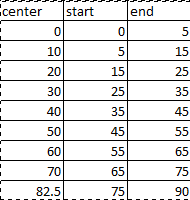First time here? Check out the Help page!
 | 1 | initial version |
Hi,
let me answer to some of your questions.
Where do patches start and end? Regarding to where patches start and end:

Center angle (we call it theta) is in degrees. Now, for standard basis you would get this (pay attention that first patch is not from 0 to 45 but rather from -22.5 to 22.5 - talking of phi angle here):

I suppose this would answer you question on how pathces are created?
Also, in what unit are these values in the 2d matrix of e+?
As for use in BSDF there are no units except for description of theta angle which is given in degrees.
Are there any other things i should consider using this approach?
Need more details on what exactly are you doing. In general, BSDF should give you pretty much correct results. Pay attention that daylighting model is single-bounce. So no multiple ray bouncing. Everything that goes through BSDF window in EnergyPlus will hit some surface and then will be bounced as perfectly diffuse.
How large can the matrix be to get reasonable runtime?
Go ahead and play with it. We are generally using standard basis (matrix that you exactly described above). However, you are not limited to this. One problem is that WINDOW 7 that is often used to create does not support yet anything that is not standard. It have only: quarter, half and full (standard) basis. Hopefully, that will be changed in near future.
Is it possible to have asymmetric matrices?
No. That is of course possible, but not implemented either in EnergyPlus nor in WINDOW.
Is it possible to treat direct and diffuse separately?
There should be some variables in EnergyPlus that should give you what is coming from diffuse and what is coming from direct beam. Just run it once and take a look at rdd file. That file contains all possible output variables for a given simulation. Once you find desired variable, you still have to insert it into IDF file.
Hope this helps.
Simon
